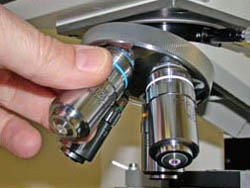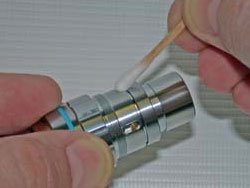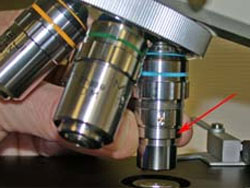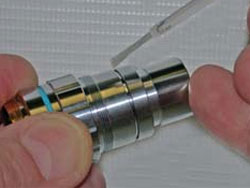|
 Remove the objectives that you wish to parfocal from the microscope. You will need to remove each objective and the outer covers will need to be opened. Remove the objectives that you wish to parfocal from the microscope. You will need to remove each objective and the outer covers will need to be opened.
If you have a 4x or a 10x objective in your microscope, leave those in place. These will not have adjustable settings.
The higher power objectives will be parfocalled using the 10x objective as a base line. The other objectives will be adjusted in order moving up from the 10x microscope objective.

Step 1: Remove Objective Outer Cover
Start by removing the outer cover of the objective lens. On the Meiji microscope objectives the objective cover will unscrew by turning it counter clockwise, like most threaded devices. The cover should unscrew easily and shouldn't have to be forced.
If you are removing the covers of multiple objectives at one time make sure that you do not mix them up!
Step 2: Adjust the Parfocallity Ring

The arrow in this image is pointing to the ring that allows you to adjust the parfocallity of the objective lens.
Begin by trying to turn the ring. If the ring moves then you may skip the next image and set of instructions. If the ring does not move it is most likely because there is a dab or drop of optical cement that is keeping it from rotating.
You may have to look closely in order to locate the drop of optical cement holding the ring in place.
Step 3: Remove the Optical Cement (if required)

You can remove the optical cement on the objective adjustment ring. If it can't be removed with your finger nail you may want to lightly moisten a Q-tip with acetone and carefully remove the dab of cement. You may need to work the ring back and forth to make the ring spin freely.
After the ring is free re-install the objective (this time without the cover on it) on the microscope. Make sure you put the next highest objective after the 10x so the objectives ascend in order. (For example, place the 10x, then 40x, 100x, etc.)
Step 4: Test the Objective Lenses
 Rotate the 10x objective into position and focus on an object. A stage micrometer is a good item to focus on, but you can use anything with lines on it. Now move up to the next objective. While you are looking through the next microscope objective rather than using the focusing knobs to focus, rotate the adjustment ring on the objective. Rotate the 10x objective into position and focus on an object. A stage micrometer is a good item to focus on, but you can use anything with lines on it. Now move up to the next objective. While you are looking through the next microscope objective rather than using the focusing knobs to focus, rotate the adjustment ring on the objective.
The adjustment is somewhat sensitive, so you might have to move it slowly.
You will then repeat this process for the rest of your objectives. When you are done with all the objectives you should be able to quickly cycle through each one without having to re-focus your microscope.
Step 5: Secure the Parfocallity Ring
 Finally, you may want to apply a drop of optical cement to secure the objective ring that you just adjusted. This is not required, but is sometimes helpful in keeping your objectives parfocalled. Finally, you may want to apply a drop of optical cement to secure the objective ring that you just adjusted. This is not required, but is sometimes helpful in keeping your objectives parfocalled.
If you don't have any optical cement just substitute clear nail polish. You can add the cement while the objectives are still in the microscope nosepiece. The photo at left shows where to apply the cement.
Once the cement has dried replace the objective covers and screw the objectives back into the nosepiece of the microscope. Parfocalling of microscope objectives should only need to be performed once, so you should be done with this task.
|
